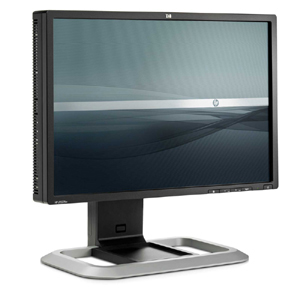
2

3 Understanding TFT -LCD technology Thin -film transistor (TFT) technology refers to a type of liquid crystal display (LCD), also known as an active -matrix LCD (AMLCD), used in all HP LCD monitors as well as HP iPAQ devices an d HP notebook displays. To understa nd how pixel defects occur, it helps to understand the technology behind this type of LCD. How LCDs work A liquid crystal is exactly what it sounds like: a fluid substance which also exhibits some properties -such as an or dered arrangement of its molecules -similar to a solid crystal. In 1963, an RCA researcher discovered that liquid crystals can be used to control light, by switching a voltage across the material on and off. Before long, the technology was being applied to everything from calculators to computer monitors. Because of their long, rod -like shape and electrical properties, liquid crystal molecules tend to line up in parallel rows in their natural state. When used in computer displays, this material is enclosed between two pieces of glass (in a flat panel display) and an image is generated by controlling the alignment of the LC molecules electrically, causing them to effectively act as "light valves" -letting light either pass through the panel or be blocked, depe nding on the voltage applied across the material. Color filters are placed on one side of the glass panels, with three different colors (red, green, and blue) for each pixel. Combining red, green, and blue light in different amounts, controlled by the volt age applied across the LC material at each of these individual areas (called subpixels) lets each pixel appear as any color and any brightness, and the combination of all the pixels on the panel creates the complete image. Fluorescent lights (very similar to the fluorescent tubes used in standard office lighting, but much smaller) or light -emitting diodes (LEDs) provide the "backlighting" for the LCD display -the light that will pass through the panel from the rear, and so create the image. The light from th e backlight unit passes through a translucent plastic diffuser layer, which spreads the light evenly across the screen. Why TFTs? In the simplest LCD technology, the voltage applied across the LC material is delivered by transparent row and column electrod es, lines of conductive material which cross at 90 degrees (one set on the "top" glass, and the other on the bottom). The intersection of rows and columns define the pixels and subpixels of the display, and applying a voltage to a given row and column swit ches the pixel at that particular intersection. If the panel is driven such that the pixels are switched, in order across the display, very rapidly, the appearance of a complete image is produced. Unfortunately, when the drive voltage is removed from a giv en pixel and we move on to the next, that first pixel starts to switch back to its "off" state. This limits the contrast, resolution, and the response time that can be achieved with such a simple, passive -matrix drive system.







![前ページ カーソルキー[←]でも移動](http://gizport.jp/static/images/arrow_left2.png)
















